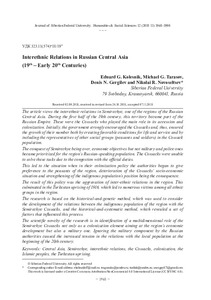Interethnic Relations in Russian Central Asia (19th – Early 20th Centuries)
Скачать файл:
URI (для ссылок/цитирований):
https://elib.sfu-kras.ru/handle/2311/109231Автор:
Kolesnik, Eduard G.
Tarasov, Michael G.
Gergilev, Denis N.
Novoseltsev, Nikolai R.
Колесник, Э.Г.
Тарасов, М.Г.
Гергилев, Д.Н.
Новосельцев, Н.Р.
Дата:
2018Журнал:
Журнал Сибирского федерального университета. Гуманитарные науки. Journal of Siberian Federal University. Humanities & Social Sciences;2018 11 (12)Аннотация:
The article views the interethnic relations in Semirechye, one of the regions of the Russian Central Asia. During the first half of the 19th century, this territory became part of the Russian Empire. These were the Cossacks who played the main role in its accession and colonization. Initially, the government strongly encouraged the Cossacks and, thus, ensured the growth of their number both by creating favorable conditions for life and service and by including the representatives of other social groups (peasants and soldiers) in the Cossack population.
The conquest of Semirechye being over, economic objectives but not military and police ones became prioritized for the region’s Russian-speaking population. The Cossacks were unable to solve these tasks due to the congestion with the official duties.
This led to the situation when in their colonization policy the authorities began to give preference to the peasants of the region, deterioration of the Cossacks’ socio-economic situation and strengthening of the indigenous population’s position being the consequence.
The result of this policy was the aggravation of inter-ethnic relations in the region. This culminated in the Turkestan uprising of 1916, which led to numerous victims among all ethnic groups in the region.
The research is based on the historical-and-genetic method, which was used to consider the development of the relations between the indigenous population of the region with the Semirechye Cossacks, and the historical-and-systematic method, which revealed a set of factors that influenced this process.
The scientific novelty of the research is in identification of a multidimensional role of the Semirechye Cossacks not only as a colonization element aiming at the region’s economic development but also a military one. Ignoring the military component by the Russian authorities caused the increased tension in the relations with the local population at the beginning of the 20th century Предметом исследования настоящей статьи являются межнациональные отношения в одном из регионов российской Центральной Азии – Семиречье. В течение первой
половины XIX в. эта территория вошла в состав Российской империи. Главную роль
в присоединении и колонизации Семиречья сыграло казачество. Первоначально правительство всячески поощряло казачество и обеспечивало рост его численности как
путем создания благоприятных условий для жизни и службы, так и за счет включения в состав казачьего населения представителей других социальных групп (крестьян
и солдат).
С окончанием процесса завоевания Семиречья приоритетными для русскоязычного
населения региона стали не военно-полицейские, а экономические задачи, решить которые казачество было не в состоянии в силу перегруженности служебными обязанностями.
Это привело к тому, что власти начали отдавать предпочтение в колонизации региона крестьянам. Следствием явилось ухудшение социально-экономического положения
казачества и усиление позиций коренного населения.
Результат подобной политики – обострение межэтнических отношений в регионе,
кульминацией чего стало Туркестанское восстание 1916 г., приведшее к многочисленным жертвам среди всех этнических групп региона.
В основе исследования лежит историко-генетический метод, с помощью которого
был рассмотрен процесс развития отношений коренного населения региона с семиреченским казачеством, и историко-системный метод, который позволил определить
совокупность факторов, влиявших на этот процесс.
Научная новизна исследования обусловлена выявлением многомерной роли семиреченского казачества не только как колонизационного элемента, основной задачей которого было экономическое освоение региона, но и военной составляющей, игнорирование которой русскими властями привело в начале XX в. к усилению напряженности
во взаимоотношениях с местным населением

